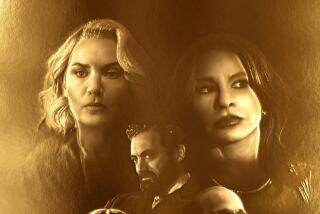‘How to Make It in America’
Although it shares industrial DNA with “Entourage” -- some executive producers, a network -- and concerns young men who go to parties and clubs, “How to Make It in America,” premiering Sunday on HBO, is a different kettle of testosterone. There is more estrogen in the mix, for one thing.
As the title suggests, success is something that will come to its characters after a time. Vincent Chase and his Hollywood pals might be high-fiving or fist-bumping or whatever it is the kids do now over the luxurious goods and services that adorn their celebrity, but it only takes a couple of cafes con leche to make Cam (Victor Rasuk) and Domingo (Scott “Kid” Mescudi) declare that life is good.
Our heroes are hapless entrepreneurial running mates Ben (Bryan Greenberg), a nice, sensitive Jewish boy, and Cam, an energetic Dominican who is sort of a can-do Scrappy-Doo to Ben’s worrying Scooby. When we meet them, they are scrabbling to pay back a loan from Cam’s cousin Rene (the ubiquitous Luis Guzman), a mug lately out of the jug who is trying to go straight as a local distributor of a Jamaican energy drink. They will borrow from him again, to fund their quixotic dream of an empire based on blue jeans.
Their friends include Gingy (Shannyn Sossamon), who runs a struggling art gallery; Rachel (Lake Bell), the ex-girlfriend for whom Ben pines and a protegee of interior designer Edie ( Martha Plimpton); and David, called “Kappo” (Eddie Kaye Thomas), an uncool, but not unlikable, hedge fund manager who can’t get past the velvet rope on his own. Actually, the whole thing is a lot closer to “Friends” in some ways than it is to “Entourage.”
On one level, it makes no sense that all these people would be hanging out together: There is something of the “Mission: Impossible” Assortment-Pack School of Character Creation about them: Jewish guy, Latino guy, black guy, rich guy, and so on. But the actors are bound by an easy rapport that makes it work. Rasuk in particular brings delicate colors to a character who could easily be a stooge.
Certainly, this is something of a fairy tale of New York, but it largely hums with an easy and attractive naturalism. Creator Ian Edelman keeps his characters on the right side of caricature and avoids the kind of melodramatic confrontations their relations might typically suggest. (When characters do act melodramatically here, they are sort of embarrassed about it afterward.) Most of the people we meet act decently to one another, the way that people mostly do.
Perhaps if I were a New Yorker myself, sharing the metropolitan air with folks something like these, I would like this show less. I can’t watch “Entourage,” which strikes me, perhaps unfairly, as a celebration of the worst parts of my town. But New York is a kind of fairy tale to me, and I can be persuaded to believe things a native would not.
Anyway, I wish these characters their successes and hope they take their time getting there.



